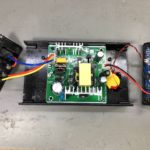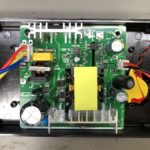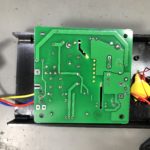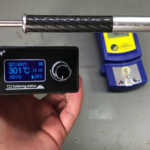Welcome to a new voltlog, today we’ll have a little chat on epaper displays. You probably saw this post I made to my youtube community page a few days ago, it was about my epaper thermometer which suddenly showed the low battery sign and stopped working. I’ve only had this running for 1 month, when I received it, the battery was not connected so I thought it must have been an old battery or a bad one.
Category: Teardown
This category will hold teardown articles.
Voltlog #241 – The World’s Cheapest Digital Watch (Teardown)
The only thing that seemed interesting when I first saw this was the price which was $0.90 delivered. I could not believe that you can get a wrist watch for 90 cents delivered from China and yet it’s true and there are still models that sell for under $1 dollar.
Voltlog #234 – The Problems I Found With The KSGER T12 Soldering Station
In a previous Voltlog I reviewed this KSGER T12 soldering station, it was the first station I got my hands on from this manufacturer, it’s version 2.1S and I was pleasantly surprised by the features it has. If you haven’t seen that video I will link it on screen right now. Since then I’ve been using it as my main soldering station and I’ve been pretty happy with how it works but some of my viewers who have been using these for longer have pointed out a few things I missed in the video so this will be a quick update video to show the things I’ve missed previously.
Voltlog #232 – My New Prefered T12 Soldering Station KSGER V2.1S
Out of the three T12 stations that I have, this is now my favorite and will be the one I use daily. I’m not sure if the performance is higher or similar to the other I have, I’ll probably do a separate video to compare them but it’s just the user interface, the menu options, the nice handle that make me wanna use this instead of the others. Yes it has a few disadvantages regarding this handle, it does get warm and it doesn’t really fit that well with a regular stand but I can go past those disadvantages for how nice this station is. If you’re looking for a T12 station this is definitely the one to get.
I also did a second video where I showed the problems I found with this soldering station and if they can be fixed by the user or not.
Voltlog #231 – Nitro OBD2 Chip Tuning Scam
Welcome to a new Voltlog, today we’re going to be taking a look at this gadget the nitro OBD2 performance chip tuning box, notice this is specially designed for diesel cars and since it’s using the buzz word nitro, this sounds like it might just work. For sure some company has invested time & money into finding the secret sauce to put into this thing to make it work and boost performance. They claim it fits all cars built after 1996 and all you have to do is to plug this into the obd port, drive for 200km so the device can learn and adjust to your car and after that you will benefit from 35% more power and 25% more torque. It evens says here on the box that it will enable fuel saving. So this sound pretty much like the holy grail in car ECU tuning.
But ofcourse if you have any experience with electronics you can’t believe that this is going to save any fuel or boost any performance just by plugging into the OBD port. So that’s why I purchased this, so we can take a better look inside, and also because I needed an OBD2 connector + enclosure for a project of mine. I plan to do some can bus sniffing and do something with that data but I’ll talk abou that in a future video.
Voltlog #228 – LIDL UltimateSpeed Car Battery Charger Teardown
It’s been a long time since we looked at a product from LIDL so today I have this lead acid battery charger which I got for about $16. From time to time they have these collections of automotive related products, they had this charger among other stuff but it really caught my eye because of this marketing wank which is printed on the box, this thing has a FLIRT Processor and if you were wondering what the hell is a FLIRT processor, it’s a FULL LOGIC INTELLIGENT REGULATION TECHNOLOGY which in my opinion sounds like the kind of title you would find stuffed with keywords on Aliexpress, except they made it an acronym and slapped a chip icon next to it.
Voltlog #225 – Taking A Look Inside A Bosch/Audi ECU EDC15VM+
Welcome to a new voltlog, today we’re doing a teardown of an automotive ECU which stands for engine control unit. Every car has one of these, unless it’s very old and doesn’t have electronic control of the engine. This is a small computer that reads a bunch of sensors like air temperature, air pressure, fuel pressure, rpm, crank shaft position, pedal position and various others and then based on these inputs will calculate various parameters and control outputs like the fuel pump, injectors, spark plugs, etc.
I’ve never opened one of these up but we should find something interesting to see in here, at least from the point of view of construction methods because these things need to run smooth even in the hardest conditions like very hot weather or very cold weather as well as endure water pouring right onto them all while withstanding high levels of mechanical shock and vibrations. So it’s likely we will see a nice seal on the enclosure, as well as conformal coating on the inside.
What we find inside might differ a lot depending on the generation of the ECU, older ones having to use more discrete components, while newer ones are integrating a lot of components into a single chip. I’ve worked briefly for Freescale which was building such a newer chip in partnership with BOSCH and it was amazing the level of integration they had: everything from multiple mosfet drivers, differential amplifiers for current sensing with programmable gain, dc-dc boost converter as well as a multi core processor was all integrated on the same chip, as you can imagine this can save quite a bit of money on the final build so that’s the direction things are heading.
The one I have here is from an Audi A6 model C5 which was manufactured between 1997 and 2004, this one is likely made in 2001, judging by a date code I see on the label and it’s from a 2.5 liter TDI engine. I got it from one of these auto dismantling businesses from ebay, I don’t know if it’s ever been opened before, but we will find out soon.
Voltlog #218 – Shower thermometer teardown after 10 months of usage
Welcome to a new voltlog, today we’re going to be doing a bit of a destructive teardown on this shower thermometer. You might remember this from 10 months ago in voltlog #172, I got it 10 months ago and ever since it’s been running in my shower and I’m interested in seeing how this looks on the inside after 10 months of usage.
After about 2-3 months of usage I’ve noticed I was getting different temperature readings for the water that I was previously considering warm enough but at that time I figured it was because of the change from summer to winter and I blamed it on the ambient temperature. However I now checked with a thermocouple and the result was pretty bad, the shower thermometer is way out.
Voltlog #214 – How bad is a fake apple lightning to 3.5mm audio adapter?
Welcome to a new voltlog, today we’re taking a look at these lightning to 3.5mm audio adapters that you have to use ever since apple removed the 3.5mm jack on the iphone. So you know the story, apple removed the jack and said it’s because they will free-up space inside the phone and it makes it more waterproof but if you ask me that’s bullshit, they removed it to force people to buy bluetooth headphones. But anyway we won’t go into that, this video is about the adapter that they now give people to still be able to use the 3.5mm jack for audio.
This made me wanna take a closer look so here are the two adapters, the plan is to connect a 3.5mm jack, this will provide me with some contacts where I can probe with the oscilloscope. I’m gonna generate a known constant waveform from an app and we’re going to measure that and compare between the two adapters.
Voltlog #211 – Joulescope DC Energy Analyzer Review & Teardown
Welcome to a new voltlog, today I’m excited because we’re going to take a look at an awesome piece of instrumentation. I’ve received a pre-production demo unit of the Joulescope DC Energy Analyzer.
The joulescope is a low cost precision dc energy analyser which is currently on kickstarter so check the links in the description of the video for the kickstarter campaign because it has a massive discount from the retail price. The joulescope has circuitry for measuring voltage and current, from which it can calculate power and then it can integrate power over time to calculate energy. The current measurement range is from 10A al the way down to 1nA, that’s a huge dynamic range which makes it very useful if you plan to measure the energy consumption of a device that has mixed behavior for example an esp32 that will wake up, do some activity and then go back to deep sleep.
The joulescope works with a software companion that has a multimeter view and an oscilloscope view which I find very useful because it will allow you to time correlate measurements of voltage and current. That can be extremely useful when determining the energy usage of your device.







